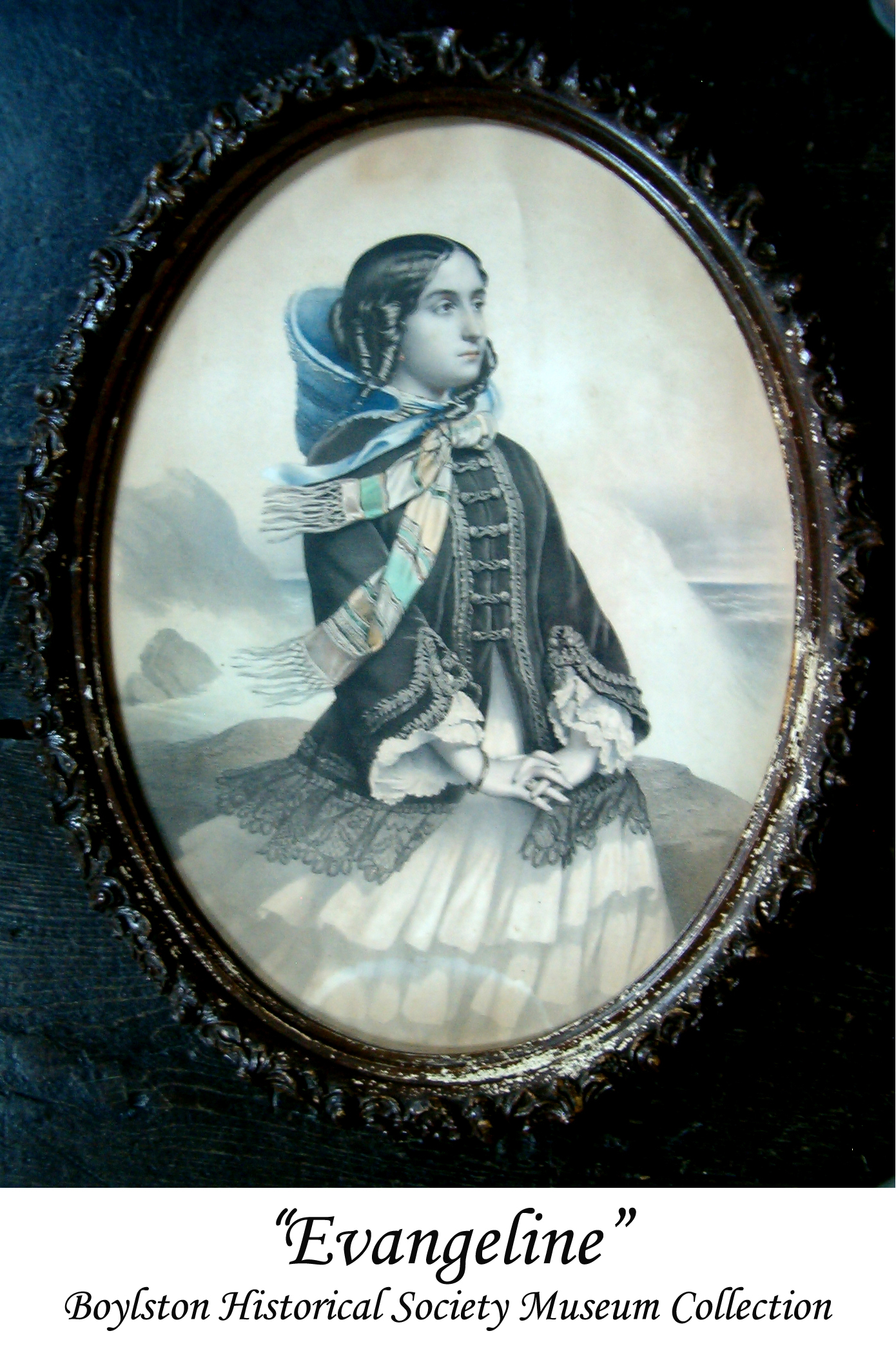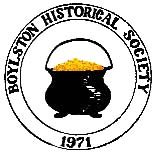Evangeline
Evangeline
By Judy Haynes
 In the Boylston Historical Society Museum hangs a mid-nineteenth century pencil and watercolor engraving titled “Evangeline,” which was a favorite of Mary Gough, the wife of John B. Gough. Once hung in the historic John B. Gough House at Hillside in Boylston, Massachusetts, this beautiful oval framed engraving depicts a young maiden with hair in curls, bonnet and fancy dress, which is the artist’s rendition of the young maiden in the 1847 epic poem by Henry Wadsworth Longfellow “Evangeline: A Tale of Acadie.” The poem mentions the maidens of ‘Acadie’ wearing “Norman caps and their kirtles of homespun.”[1] A native Normandie fashion of that era would have actually had a tall bonnet with a blouse and kirtle (skirt) of a rather simpler style; which would be a better match for a farmer’s daughter as depicted in the Longfellow epic.
In the Boylston Historical Society Museum hangs a mid-nineteenth century pencil and watercolor engraving titled “Evangeline,” which was a favorite of Mary Gough, the wife of John B. Gough. Once hung in the historic John B. Gough House at Hillside in Boylston, Massachusetts, this beautiful oval framed engraving depicts a young maiden with hair in curls, bonnet and fancy dress, which is the artist’s rendition of the young maiden in the 1847 epic poem by Henry Wadsworth Longfellow “Evangeline: A Tale of Acadie.” The poem mentions the maidens of ‘Acadie’ wearing “Norman caps and their kirtles of homespun.”[1] A native Normandie fashion of that era would have actually had a tall bonnet with a blouse and kirtle (skirt) of a rather simpler style; which would be a better match for a farmer’s daughter as depicted in the Longfellow epic.
In Henry Wadsworth Longfellow’s (1807-1882) work,[2] the maiden “Evangeline Bellefontaine” is the daughter of a farmer in the village of Grand Pre, part of the Norman French colony known as Acadia, today’s Nova Scotia. The watercolor “Evangeline” engraving in the Boylston Historical Society Museum is shown in a fancy fashionable attire which seems to be an interpretative portrayal of an Acadian maiden. While her facial demeanor in the frame is serious, but hopeful, it does not show the extreme sadness that would be felt for the many years searching and wanderings from Acadia to Louisiana and back North again, looking for her long-lost loved one, Gabriel. While she is working as a Sister of Mercy in Philadelphia, Pennsylvania, caring for the sick, Evangeline finally finds him. Gabriel lies dying and the story ends with the two reunited in love as death approaches.
The epic is a work of fiction, but is based on the true story of the expulsion of the Acadian people that began in September 1755, by the English king. Longfellow takes liberty to create the scenes where his heroine flows through, but the overall theme depicts the horrific plight of the Acadian people. Acadia was a French colony from 1604 to 1713 until the English took possession of the lands under the Treaty of Utrecht, which “provided that the province of Acadia, or Nova Scotia, be ceded by the French to the English government.”[3] The French Acadians were “indulged” and stayed until 1755. Prior to the final expulsion one could swear allegiance to the British and bear arms against the natives and stay in Acadia. To bear arms against the native Micmac Indians who the Acadians had maintained friendly relationships with was not something they desired to do, and the British no longer trusted their true allegiance; thus, so they were deported. They were allowed to take their money and personal belongings and to remove themselves leaving the lands, cattle, and other livestock to the Crown. From Grand Pre alone, where Longfellow has set his story, 1,923 people left (483 men, 337 women and 1,203 children). Many of the Acadian folk ended up in Louisiana and are those with Acadian roots known as Cajuns. In all some 10,000 Acadians were removed and nearly 53% of them died either by disease or drowning or injury upon the removal. It was in reality a very sad time for those folks.
The underlying theme of “Evangeline” represents “lost love and heartbreak, while keeping hope.”[4] That is a message that meant a great deal to the Acadians as they told their own history of expulsion during the Seven Years War period referred to as “The Great Upheaval” from 1755 to 1763 when the Acadians taken as prisoners of war were deported from Nova Scotia to the British American colonies and Europe. Longfellow had personally experienced love loss when his first wife died just a few years after he married in 1831 and this experience may have provided the inspiration to write of this sad and longing for one’s lost love in the epic poem.[5] He did marry again in 1843, and it was Reverend Horace Conolly an attendee at the dinner of Nathaniel Hawthorne in 1840 who first related the story of the Acadian bride-to-be wandering to find her fiancé. Conolly shared it in hopes that Nathaniel Hawthorne would write a story about the Acadian people, however it was Henry Wadsworth Longfellow who reported the story to be “the best illustration of faithfulness and the constancy of woman that I have ever heard of or read.” Seven years after with Nathaniel’s blessing, Henry turned it into a poem.
The poetic work was published in 1847, and is 25 pages long in the “Household edition” of the Poetical Works of Henry Wadsworth Longfellow, but in the Ticknor and Fields edition, with illustrations it runs 58 pages, truly an epic. “Evangeline” is one of several of Longfellow’s New England Tragedies, which also include the familiar Tales of a Wayside Inn, among others. “Evangeline” is said to be one of Longfellow’s most popular works. Our Fuller Research Library at the Boylston Historical Society Museum has both copies of these books available for your perusal.
This engraving unfortunately has no visible artist’s or markings on it, however the provenance which is written on the backside of the framed engraving includes descendants of John and Mary Gough. After Mary Gough died, her niece, Miss Mary G. Whitcomb who had resided with her Aunt Mary and Uncle John during her youth inherited the engraving. Upon her death it was bequeathed to Mrs. Mary E. French. Mrs. French then gave it to her brother in November 1933, and it was passed down in the French family and subsequently donated to the Boylston Historical Society Museum in 1980 by Norman French.
Why was this particular picture a favorite of Mrs. Gough? What drew her to this young maiden? Was it love lost? Or perhaps was it Mrs. Gough’s compassionate heart for the plight of the Acadian people? The name Evangeline is derived from “gospel” and means “good news.” Perhaps this was the appeal to Mrs. Gough, this representation of genuine goodness?
Make an appointment any Sunday from 2-4pm to tour our museum to view this exquisite engraving which elevated Longfellow to be considered one of the most famous writers in America in the mid-nineteenth century.
[1] The Poetical Works of Henry Wadsworth Longfellow, Boston: Ticknor and Fields, 1868, “Evangeline,”pp.1-58.
[2] Anthology of American Poetry, Crown Publishers, 1983, p. 107 brief bio of Henry Wadsworth Longfellow.
[3] The Poetical Works…, “Notes,” pp729-735.
[4] Wikipedia, Longfellow’s “Evangeline.”
[5] Longfellow bio in Anthology of American Poetry, p. 107
Boylston Historical Society & Museum Collections, Boylston, Massachusetts
Editor, Nancy Filgate, Boylston, Massachusetts
Evangeline: A Tale of Acadie, www.hwlongfellow.org
Photography, Nancy Filgate, Boylston, Massachusetts
The Legend of Evangeline, www.loc.gov, Library of Congress
Published 3 September 2021
